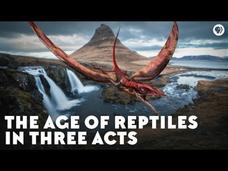California Academy of Science
What is the Environmental Impact of Feeding the World?
One in every seven people suffer from a lack of basic food. Our Hungry Planet introduces this complex issue in the second lesson of an interesting 13-part unit. It discusses the space needed to grow and raise food, the transportation of...
TED-Ed
The Survival of the Sea Turtle
Sea turtles face a lot of adversity: storms, predators on land and in the sea, and eggs that don't hatch, but the biggest threat to these magnificent and ancient creatures is human activity. From poaching to pollution, from trash to...
PBS
When the Synapsids Struck Back
As environments change so must their inhabitants, or extinction will prevail. An in-depth look at the evolution of the synapsids shows how one group overcame environmental changes and survived. The video lesson from the PBS Eon series...
PBS
The Age of Reptiles in Three Acts
Reptiles survived the largest extinction event on the planet and then they grew into the most dominant class of the Mesozoic Era. They quickly evolved into giants on land, sea, and air. In an episode of the PBS Eons series viewers learn...
TED-Ed
How Long Will Human Impacts Last?
If aliens visit Earth a million years from now, what will they find? Explore the Anthropocene epoch with a hard-hitting video. Viewers examine the changes humankind has made to the planet, how these overshadow events of the past, and...
California Academy of Science
Vertical Farming
Half of crops from traditional farming never get harvested, while 90 percent of crops from vertical farming go into the food supply. As land runs out for farming and the need for crops increases, could vertical farming solve the problem?...
California Academy of Science
Think Before You Eat
Small changes in individual diets add up quickly, which is the theme of the ninth lesson in the 13-part Our Hungry Planet unit. Viewers watch a video to learn basic facts before reading a handout and discussing their own choices.
Howard Hughes Medical Institute
Stickleback Film with Quiz: Evolving Switches, Evolving Bodies
The pelvic bone's connected to the...nothing in the stickleback fish, because it doesn't have one. Young biologists watch a video about the evolution of the stickleback fish living in Alaskan lakes. It turns out that they lost their...







